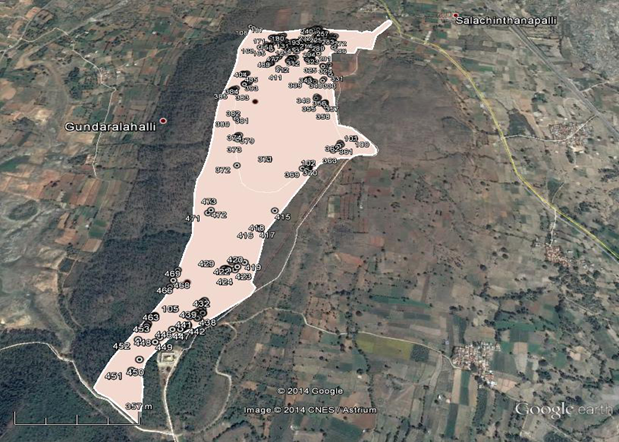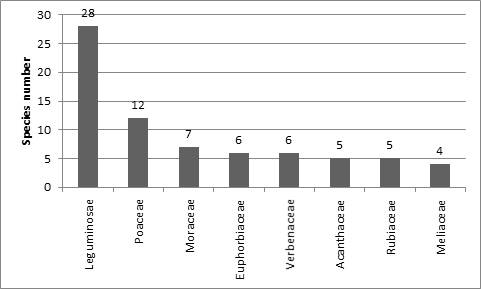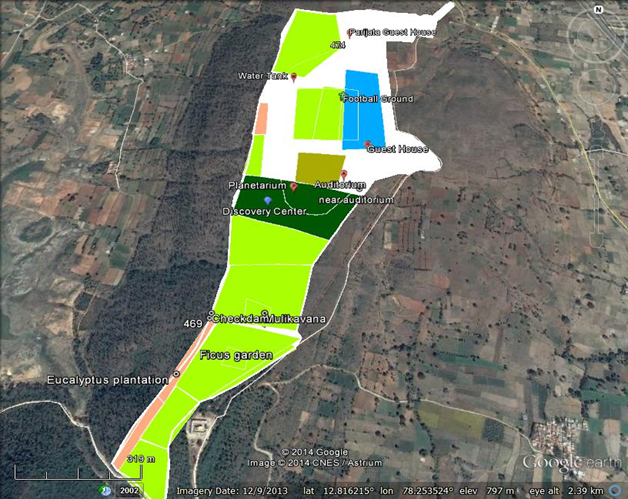|
|
Floristic Diversity and Lanscape Planning
|
The vegetation of the area presently consists of grassland with scattered trees and scrub forest. However the natural vegetation of the area broadly comes under dry deciduous type being nearer to the foot hills of Eastern Ghats. Rainfall also being lesser than 1000 mm/year support more of drier forest adapted to water paucity. Some of the areas have been planted with Western Ghats plants and other exotics. Hence the vegetation of the area can be broadly divided into
- Tropical dry deciduous
- Scrub thickets
- Grasslands
- monoculture plantation
- aquatic plants
- introduced plant species
METHOD: Campus area vegetation was opportunistically surveyed (for 3 days) for plant diversity mainly, trees, shrubs, climbers and herbs. Bigger trees and tree clumps were documented using GPS (Global positioning system). Other parameters such tree girth, tree height and canopy size were recorded.

Figure 1: trees mapped in the campus area (numbers indicate tree or tree clumps)
RESULTS AND DISCUSSION
The vegetation survey yielded a total of 141 plant species belonging to 57 families, comprising of 68 species of Trees, shrubs 12, climbers 11 and herbs with 50 species. Largest families are shown in figure 2.

Figure 2: Family wise flora with the number of species
Common plant species in the campus area: As the area comes under the low rain fall zone, coupled with earlier disturbances, the area mainly comprised of grasslands and scrub thickets with very less woody vegetation. Commonly seen larger trees are Pterocarpus santalinus, Azadirachta indica, Syzygium cumini, Cassia siamea, Cassina glauca, Terminalia arjuna etc. (table 1).
Table 1: Most commonly seen trees in the campus.
Sn |
Most common trees |
|
|
1 |
Acacia auriculiformis |
12 |
Pterocarpus santalinus |
2 |
Syzygium cumini |
13 |
Ficus benghalensis |
3 |
Cassia siamea |
14 |
Albizzia lebbeck |
4 |
Azadirachta indica |
15 |
Holoptelia integrifolia |
5 |
Cassine glauca |
16 |
Madhuca indica |
6 |
Terminalia arjuna |
17 |
Pongamia pinnata |
7 |
Ficus religiosa |
18 |
Butea monosperma |
8 |
Eucalyptus sp |
19 |
Tamarindus indicus |
9 |
Mangifera indica |
20 |
Artocarpus integrifolius |
10 |
Bauhinia purpurea |
21 |
Cassia fistula |
11 |
Calophyllum inophyllum |
|
|
Common shrub species in grassland-scrub areas are Dodonaea viscosa, Toddalia asiatica, Cocculus hirsutus, Gloriosa superba, Crotolaria auriculata, Hyptis suaveolens, Leucas aspera, Argyrea cuneata, Canthium parviflorum, etc.
Among the herbs, Lepidagathis cristata, Euphorbia hirta,Evolvulus alsinoides, Andrographis serpyllifolia, Indigogera tinctorea, Hybanthus enneaspermus,Justicia simplex, Leuca slinifolia, etc were common. Commonly found grasses include Apluda mutica, Chryosopogon fulvus, Aristida setacea, Heteropogon contortus, etc.
Medicinal plants in campus area: A total of 71 medicinal plants were noted in this short survey. The detailed list is given in the table 2. Important medicinal plants include Balanites sp, Cassia fistula, Salacia chinensis, Tinospora cordifolia, Evolvulus alsinoides, Gloriosa superba, Pterocarpus santalinus, Sida acuta etc. Many Vanas and gardens hosted these plants in the campus area. Grasslands also harboured large number of medicinal plants and hence have to be conserved.
MANAGEMENT OPTIONS FOR CAMPUS PLANTS AND WILDLIFE

Figure 3: Google image mapped for existing vegetation landscape types for management planning (Colours: Light green-Pure grasslands with sparse scrub, Orange-Eucalyptus plantations, Dark green-Scrub thickets with some native trees planting along with Acacia auriculiformis, Olive green-Dodonea shrub mix grassland, Blue- Western ghats and other plantation trees planted scrubby area. White- scrubby grassland used for mango plantations, Acacia plantations, Western Ghats saplings, and some exotics).
The area has been under random planting from its earliest initiation with both native and exotic trees.
- Grassland areas (Light green areas in figure 3): Large expanse of the southern campus are with grasslands which support many rare and native shrub, herb and grass species. These areas also along with scrub- thicket hills until auditorium also support wild mammals. Hence these regions including the ones marked for vana and other medicinal gardens are to be conserved. Random planting in the grasslands should be avoided. The heterogeneity of the landscape be enhanced in some areas with native tree species preferably those adapted to lower rain fall areas such Acacia leucophloea, Garuga pinnata, Holoptelia integrifolia, Albizzia sp, Dalbergia sp, Pterospermum santalinus,Pongamia pinnata,Schleichera oleosa, Syzgium cumini, Bauhinia vahliii, Mallotus philippensis, Phyllanthus emblica, Sterculia villosa, Bombax ceiba, Buchanania lanzanAnogeissus latifolia, Terminalia paniculata, Terminalia alata, Chloroxylon swietenia, Dolichandrone acuata, Wrightia tinctoria, Vitex altissimaStrychnosnux-vomica, Sapindus emarginatus, Drypetess epiaria, Pterospermum canescens, Drypetes ferrea, Cordia dichotoma, Flacourtia indica, Canthium parviflorum,Ziziphus rugosa and Grewia tilifolia. The selective planting of diverse native trees helps as fire line in preventing the spread of fires in grasslands during summer.
- Eastern Ghats forest planting (Dark green area in figure 3): the regions of scrub thickets and low lying drainage areas be planted with sapling from eastern ghats such Terminalia alata, Xylia xylocarpa, Anogeissus latifolia, Dillenia pentagyna, Pterocarpus marsupium, Pterospermum santalinus, Pongamia pinnata,Schleichera oleosa, Syzgium cumini, Bauhinia vahliii, Mallotusphilippensis, Phyllanthus emblica, Sterculia villosa, Bombax ceiba, Buchanania lanzan, Anogeissus latifolia, Terminalia paniculata, Chloroxylon swietenia, Dolichandrone arcuata, Wrightia tinctoria, Vitex altissimaStrychnos nux-vomica, Sapindus emarginatus, Drypetes sepiaria, Pterospermum canescens, Drypetes ferrea, Cordia dichotoma, Ficus sp, Flacourtia indica, and Grewia tilifolia.
- Western Ghats plants (Blue shaded areas in figure 3):Western Ghats trees needs soil moisture, which requires regular monitoring. Hence theirspecies sapling be planted in the regions with good water retaining abilities (valleys, etc.) Percolation ponds / trenches in wild areas also help in recharging of groundwater resources and also maintenance of moisture in the soil. Planting of the Western Ghats species in in drier areas be avoided due to water stress.
- Exotic trees: Non-native plant species be avoided and native plants with aesthetic branching, flowers, etc. be planted near guest houses, media library etc.
- Native tree groves:Groves of native fruiting trees, flowering trees, nectar gardens, medicinal gardens be developed in plain areas (white shaded areas in Figure 3) with appropriate soil and water conservation measures. These will help as a food and nectar source for birds, butterflies, and many other faunal communities.
- Wetland areas:Creation of water bodies (as discussed in the previous section) would support wild fauna (birds, mammals, etc.) apart from increasing ground water table. Development of wetlands (with aquatic emergent flora) at the inlet of water body would also help in remediation of water.
- Energy plantations and other uses:Plantations of exotic species such as Eucalyptus in southern campus be replaced in phased manner with native species (Pongamia pinnata, etc.) These having huge trees have both the use of temporary residence for faunal communities and their aesthetic looks. Planting Acacia auriculiformis, Eucalyptus should be avoided.
Over all Light green shaded areas should be exclusively used for Grassland conservation, improvement with very sparse dry deciduous tree clumps. Necessary water conservation techniques can be done here. Dark shaded areas (in Figure 3) are suitable for exclusive Eastern ghats plants and olive green shaded areas (in figure 3) withDodonea viscosa shrub and grasses be maintained without any changes.
Table 2: Checklist of Trees (T), Shrubs (S), Climbers (C), and Herbs (H), in the Campus area along with their family, endemic status and medicinal value.
Sn |
Species |
Habit |
Family |
Endemics |
Medicinal value (M) |
1 |
Acacia auriculiformis |
T |
Leguminosae |
|
M |
2 |
Acacia catechu |
T |
Leguminosae |
|
M |
3 |
Acacia farnesiana |
S |
Leguminosae |
|
M |
4 |
Acacia sp |
T |
Leguminosae |
|
|
5 |
Aeglemarmelos |
T |
Rutaceae |
|
M |
6 |
Albizialebbeck |
T |
Leguminosae |
|
|
7 |
Alysicarpusvaginalis |
H |
Leguminosae |
|
|
8 |
Andrographisserpyllifolia |
H |
Acanthaceae |
Endemic |
M |
9 |
Anthocephaluscadamba |
T |
Rubiaceae |
|
|
10 |
Apludamutica |
H |
Poaceae |
|
|
11 |
Aponogetonsp |
H |
Aponogetonaceae |
|
|
12 |
Argyriacuneata |
S |
Convolvulaceae |
Endemic to South India |
M |
13 |
Aristidasp |
H |
Poaceae |
|
|
14 |
Aristida setacea |
H |
Poaceae |
|
|
15 |
Arthraxonsp |
H |
Poaceae |
|
|
16 |
Artocarpushirsutus |
T |
Moraceae |
Endemic |
M |
17 |
Artocarpusintegrifolius |
T |
Moraceae |
|
|
18 |
Azadirachtaindica |
T |
Meliaceae |
|
M |
19 |
Balanitesaegyptiaca |
T |
Zygophyllaceae |
|
M |
20 |
Barleriabuxifolia |
S |
Acanthaceae |
Endemic to peninsular India. |
|
21 |
Bauhinia purpurea |
T |
Leguminosae |
|
|
22 |
Bauhinia racemosa |
T |
Leguminosae |
|
|
23 |
Bauhinia variegata |
T |
Leguminosae |
|
M |
24 |
Beciumfilamentosum |
H |
Lamiaceae |
|
|
25 |
Bombaxceiba |
T |
Bombacaceae |
|
M |
26 |
Borassisflabellifer |
T |
Arecaceae |
|
|
27 |
Buteamonosperma |
T |
Leguminosae |
|
M |
28 |
Callistemon sp |
T |
Myrtaceae |
|
|
29 |
Calophylluminophyllum |
T |
Clusiaceae |
|
|
30 |
Canthiumdicoccum |
T |
Rubiaceae |
|
M |
31 |
Careyaarborea |
T |
Lecythidaceae |
|
M |
32 |
Cassia auriculata |
S |
Leguminosae |
|
|
33 |
Cassia fistula |
T |
Leguminosae |
|
M |
34 |
Cassia siamea |
T |
Leguminosae |
|
|
35 |
Cassineglauca |
T |
Celastraceae |
|
M |
36 |
Celastruspaniculata |
C |
Celastraceae |
|
M |
37 |
Chrysopogon fulvus |
H |
Poaceae |
|
|
38 |
Chukrasiatabularis |
T |
Meliaceae |
|
M |
39 |
Cinnamomummalabatrum |
T |
Lauraceae |
Endemic |
M |
40 |
Clitoreatinctorea |
C |
Leguminosae |
|
M |
41 |
Cocculushirsutus |
C |
Menispermaceae |
|
M |
42 |
Crotalaria retusa |
S |
Leguminosae |
|
M |
43 |
Curculigoorchioides |
H |
Hypoxidaceae |
|
M |
44 |
Cymbopogonsp |
H |
Poaceae |
|
|
45 |
Dactylocteniumaegyptium |
H |
Poaceae |
|
M |
46 |
Dalbergialatifolia |
T |
Leguminosae |
|
M |
47 |
Delonixregia |
T |
Leguminosae |
|
|
48 |
Desmodiumsp |
H |
Leguminosae |
|
|
49 |
Desmodiumtriflorum |
H |
Leguminosae |
|
M |
50 |
Dichanthiumpertusum |
H |
Poaceae |
|
|
51 |
Dichrostachyscinerea |
S |
Leguminosae |
|
|
52 |
Digitariasp |
H |
Poaceae |
|
|
53 |
Dilleniaindica |
T |
Dilleniaceae |
|
|
54 |
Dodonaeaviscosa |
S |
Sapindaceae |
|
|
55 |
Echinochloacolona |
H |
Poaceae |
|
|
56 |
Elaeocharissp |
H |
Cyperaceae |
|
|
57 |
Eucalyptus sp |
T |
Myrtaceae |
|
|
58 |
Euphorbia bonplondianum |
H |
Euphorbiaceae |
|
|
59 |
Evolvulusalsinoides |
H |
Convolvulaceae |
|
M |
60 |
Ficusbenghalensis |
T |
Moraceae |
|
M |
61 |
Ficushispida |
T |
Moraceae |
|
M |
62 |
Ficusinfectoria |
T |
Moraceae |
|
|
63 |
Ficusmysorensis |
T |
Moraceae |
|
|
64 |
Ficusracemosa |
T |
Moraceae |
|
|
65 |
Ficusreligiosa |
T |
Moraceae |
|
M |
66 |
Flacourtiaindica |
S |
Flacourtiaceae |
|
|
67 |
Garciniacambogia |
T |
Clusiaceae |
Endemic |
M |
68 |
Garugapinnata |
T |
Burseraceae |
|
M |
69 |
Gloriosasuperba |
H |
Liliaceae |
|
M |
70 |
Hackelochloagranularis |
H |
Poaceae |
|
|
71 |
Hemidesmusindicus |
C |
Asclepiadaceae |
Endemic to Peninsular India |
M |
72 |
Heterophragmaroxbhurgii |
T |
Bignoniaceae |
Endemic to Peninsular India |
M |
73 |
Heteropogoncontortus |
H |
Poaceae |
|
|
74 |
Holopteliaintegrifolia |
T |
Ulmaceae |
|
M |
75 |
Hybanthusenneaspermus |
H |
Violaceae |
|
M |
76 |
Hyptissuaveolens |
S |
Lamiaceae |
|
M |
77 |
Indigoferatinctorea |
H |
Leguminosae |
|
|
78 |
Iphigenia indica |
H |
Liliaceae |
|
|
79 |
Jatrophacurcas |
H |
Euphorbiaceae |
|
|
80 |
Justicia simplex |
H |
Acanthaceae |
|
M |
81 |
Lantana camara |
S |
Verbenaceae |
|
|
82 |
Lepidagathiscristata |
H |
Acanthaceae |
|
M |
83 |
Leucasapera |
H |
Lamiaceae |
|
|
84 |
Leucenaleucocephala |
T |
Leguminosae |
|
|
85 |
Loranthussp |
H |
Loranthaceae |
|
|
86 |
Madhucaindica |
T |
Sapotaceae |
|
M |
87 |
Mangiferaindica |
T |
Anacardiaceae |
|
M |
88 |
Marseliasp |
H |
Marsileaceae |
|
|
89 |
Meliadubia |
T |
Meliaceae |
|
M |
90 |
Mitragynaparvifolia |
T |
Rubiaceae |
|
M |
91 |
Mollugopentaphylla |
H |
Molluginaceae |
|
M |
92 |
Moringatomentosa |
T |
Moringaceae |
|
|
93 |
Muntingiacalabura |
T |
Elaeocarpaceae |
|
M |
94 |
Murrayapaniculata |
T |
Rutaceae |
|
M |
95 |
Nympheasp |
H |
Nymphaeaceae |
|
|
96 |
Partheniumhysterophorus |
H |
Asteraceae |
|
|
97 |
Passiflorafoetida |
C |
Passifloraceae |
|
|
98 |
Pavoniaodorata |
H |
Malvaceae |
|
M |
99 |
Peltophorumroxbhurgii |
T |
Leguminosae |
|
|
100 |
Pennisetum pedicellatum |
H |
Poaceae |
|
|
101 |
Phyllanthusemblica |
T |
Euphorbiaceae |
|
M |
102 |
Phyllanthus simplex |
H |
Euphorbiaceae |
|
|
103 |
Phyllanthus maderaspatensis |
H |
Euphorbiaceae |
|
|
104 |
Plumeria alba |
T |
Apocynaceae |
|
|
105 |
Pongamiapinnata |
T |
Leguminosae |
|
M |
106 |
Premnatomentosa |
T |
Verbenaceae |
|
M |
107 |
Pterocarpussantalinus |
T |
Leguminosae |
|
M |
108 |
Pterospermumdiversifolium |
T |
Sterculiaceae |
|
M |
109 |
Salaciachinensis |
C |
Celastraceae |
|
M |
110 |
Santalum album |
T |
Santalaceae |
Endemic to India |
M |
111 |
Sapindusemarginatus |
T |
Sapindaceae |
|
|
112 |
Saracaasoca |
T |
Leguminosae |
|
M |
113 |
Schefflerasp |
T |
Araliaceae |
|
|
114 |
Schoenoplectussp |
H |
Cyperaceae |
|
|
115 |
Sidaacuta |
H |
Malvaceae |
|
M |
116 |
Spermacocearticularis |
H |
Rubiaceae |
|
M |
117 |
Spermacocehispida |
H |
Rubiaceae |
|
M |
118 |
Stachytarpetaindica |
H |
Verbenaceae |
|
M |
119 |
Strigalutea |
H |
Scrophulariaceae |
|
|
120 |
Stylosanthesfruiticosa |
H |
Leguminosae |
|
|
121 |
Sweiteniamacrophylla |
T |
Meliaceae |
|
|
122 |
Symplocossp |
T |
Symplocaceae |
|
|
123 |
Syzygiumcumini |
T |
Myrtaceae |
|
M |
124 |
Tamarindusindicus |
T |
Leguminosae |
|
M |
125 |
Tecomastans |
S |
Bignoniaceae |
|
|
126 |
Tectonagrandis |
T |
Verbenaceae |
|
|
127 |
Terminaliaarjuna |
T |
Combretaceae |
|
|
128 |
Terminaliabellerica |
T |
Combretaceae |
|
M |
129 |
Thunbergiaalata |
C |
Acanthaceae |
|
|
130 |
Tinosporacordifolia |
C |
Menispermaceae |
|
M |
131 |
Toddaliaasiatica |
C |
Rutaceae |
|
M |
132 |
Tragiainvolucrata |
C |
Euphorbiaceae |
|
M |
133 |
Tremaorientalis |
T |
Ulmaceae |
|
M |
134 |
Tribulusterrestris |
H |
Zygophyllaceae |
|
M |
135 |
Trichodesmazeylanicum |
H |
Boraginaceae |
|
|
136 |
Tridaxprocumbens |
H |
Asteraceae |
|
|
137 |
Tylophorasp |
C |
Asclepiadaceae |
|
|
138 |
Vitexnegundo |
S |
Verbenaceae |
|
M |
139 |
Vitextrifoliata |
T |
Verbenaceae |
|
|
140 |
Wrigtiatinctorea |
T |
Apocynaceae |
|
M |
141 |
Zorniadiphylla |
H |
Leguminosae |
|
M |
|




